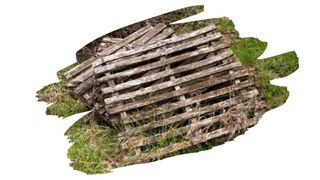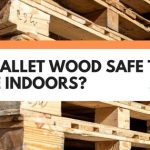Good clean burning firewood must — first and foremost — come from non-toxic trees.
But, when it comes to pallets, you can’t always be sure of what type of timber they’re made from. Or even sometimes what that wood has been treated with.
So, what should you be looking at, when it comes to checking how safe a stack of pallet wood is to burn?
Well, in this post, you’ll learn what you should check for in firewood, as it relates to fireplace safety. You’ll also discover what really goes into the manufacture of wooden pallets — and whether or not this makes them a good option for firewood.

This post may contain affiliate links to products that we receive a commission for (at no additional cost to you). Learn more here.
What Is The Safest Type Of Firewood You Can Use?
The safest type of firewood is one that won’t fill your home with noxious fumes and smoke.
That is why clean burning firewood comes from wood that doesn’t have a lot of tree sap in it. And, more importantly, it doesn’t come from a poisonous tree species.
So, natural White Oak and Birch wood are two great options for an indoor fireplace. And, provided that they’ve been well seasoned, (i.e. they are dry), they won’t emit a lot of smoke.
Related Post: How To Season Wood (7 Tips)
What’s more, they don’t contain a lot of tree sap or toxic compounds. On top of that, they’re two fairly dense timbers, meaning that they’ll burn for longer — producing more heat for your home.
And What Kind Of Wood Should Not Be Burned In A Fireplace At All?
The two types of wood you need to watch out for are the following:
- Avoid Using Wood From Poisonous Trees
Trees that have poisonous sap or toxic compounds in them, should be strictly avoided.
If you burn them in a fireplace, those compounds won’t simply disappear. Instead, they will gather in the soot, (and float around in the fumes), released by burning that lumber.
This makes these trees, (such as the Yew Tree), wholly unsuitable sources for firewood.
- Avoid Using Wood That Has A Lot Of Sap/Pitch In It
Tree sap/pitch are resins that trees produce to protect themselves from bugs and damage.
But if firewood has a lot of resin in it, those resins can cause chimney flues to become backed up. And this in turn significantly increases the chances of a chimney fire.
Which is why very resinous timber, such as Cedar or Pine, are poor options for an indoor fireplace.
Related Post: Is Ponderosa Pine Wood A Good Choice For Firewood?
What About Pallets? Are They Safe Enough To Use As Firewood?
It mostly depends on how that wooden pallet has been treated — and what it’s been treated with.
You see, natural wood can have bugs and termites in it, after it’s been freshly milled. So, to get rid of those pests, wood needs to go through a treatment process.
OK…But What Does The Treatment Of Wood Have To Do With Pallet Safety?
Well, years ago, wooden pallets were put through a fumigation treatment in order to get rid of bugs. And the substance used to disinfect those pallets was a toxic chemical called Methyl Bromide.
Now, Methyl Bromide is some very nasty stuff. If you inhale it, ingest it, or any of it gets on your skin, it can cause serious health issues.
Which is why wooden pallets that have been marked as ‘MB’ (Methyl Bromide) are much too toxic to burn in a fireplace. Particularly as the last thing anyone needs is Methyl Bromide-filled fumes floating around in their home!
However recently, the way wooden pallets have been treated has changed. And that change has made pallet wood much safer.
And What Types Of Wooden Pallets Are Safer To Use?
In the US, Canada, and UK, pallets are more likely to be treated with heat, rather than Methyl Bromide.
These high-heated pallets are referred to as ‘heat-treated’ pallets. And they are heated to temperatures so hot, that it removes all insects that may be nestled in them.
Now, there are three main types of heat-treated wooden pallets:
Heat Treated Pallets (Marked as ‘HT’)
These pallets are treated by placing them in a chamber, and baking them at temperatures of around 56°C (132.8°F) for over half an hour.
There are no fumigation chemicals involved here, which is why heat-treated pallets are safe — certainly much safer than any pallets disinfected with Methyl Bromide.
Kiln Dried Pallets (Marked as ‘KD’)
Kiln Dried Pallets get put through pretty much the same process as HT pallets. Except, they are super heated in a kiln oven, instead of a chamber.
Another key difference is the temperature they’re heated up to (and for how long).
Kiln Dried Pallets get heated to a sweltering 94°C (201.2°F) for up to 36 hours. Which is certainly more than hot enough to get rid of any pests still hanging around.
So, just like with HT pallets, KD pallets are safe to use.
Debarked Pallets (Marked as ‘DB’)
Last, but not least, are Debarked Pallets. These pallets get put through the same heat-treatment process as HT pallets.
Except Debarked pallets will have had their tree bark removed before they get put through the heating process. The reason for removing the bark is simple; it makes it easier to heat up and dry out that timber.
And, once again, similarly to HT and KD pallets, debarked pallets are also safe for you to use.
So That Means I Can Burn Any Pallet Marked HT, KD, or DB, Right?
Almost, but not quite.
While heat and fumigation do a great job at getting rid of insects, they do nothing to help stave off rot. So, if that pallet becomes damp with rainwater or humidity, wood rot can take hold. And sometimes bugs can even make a comeback as well.
Which is why wooden pallets often get put through a secondary treatment process, called pressure treatment.
And What Is ‘Pressure Treatment’?
Pressure treatments involve infusing wood with rot-resistant chemicals. The job of those chemicals is to act like a fungicide, and fight off wood rot bacteria.
However, those self-same wood preserving chemicals are made of some pretty toxic stuff too. For example, some pressure treatment wood preservatives — such as Chromated copper arsenate (CCA) — can even contain arsenic.
So How Do You Check If A Pallet Has Been Pressure Treated?
Pallet wood, that’s been put through a pressure treatment, will have a stamp clearly indicating it’s treatment.
The two main stamps for pressure treated pallets, (from the US, UK, and Canada), are GC (Ground Contact) or PT (Pressure Treated).
So, if you’re using reclaimed heat treated pallet wood, make sure you check it carefully for those GC/PT stamps.
Related Post: How To Dry Pressure Treated Wood (Quickly And Without Warping)
So, Can I Use Pallet Wood As Fireplace Fuel?
If you’re absolutely certain that pallet has not been treated with toxic chemicals, then yes you can. Especially as most types of US pallets are made from timber that’ll burn cleanly in a fireplace, such as Oak.
And even heat-treated pine wood pallets won’t have much sap left in their timber. That’s because that high-heat treatment will have evaporated away any left over tree sap.
But, you should always avoid burning any old or reclaimed pallet wood that you aren’t 100% sure about. If you don’t know exactly what treatments that pallet has been put through, then it’s simply not worth taking the risk in burning it.
To Wrap Up, Here Are The 3 Key Takeaways From This Post…
- 1). Do not burn chemically treated wood in an indoor fireplace.
- 2). Wooden Pallets marked as ‘MB’ will have been treated with toxic Methyl Bromide.
- 3). The safest type of pallet wood will have been heat-treated. But, they’re only safe to burn if they have not been pressure treated with additional chemical wood preservatives.
References:
Overview of Wood Preservative Chemicals | U.S. Environmental Protection Agency (US EPA)
Methyl Bromide | U.S. Environmental Protection Agency (US EPA)



